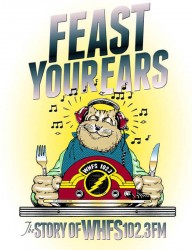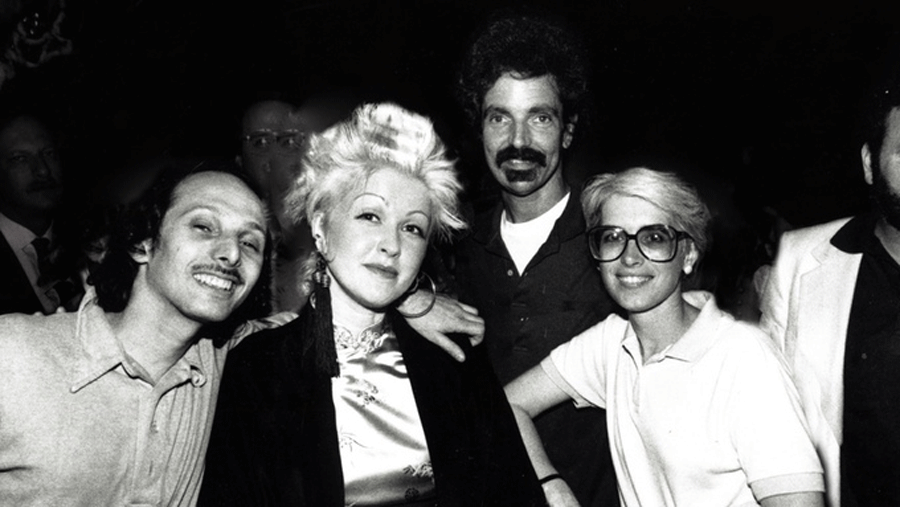“WHFS in Bethesda, Maryland, coming to you from high atop the Triangle Towers. Ease on back, take your clothes off and have some wiiiine…”
If you listened to D.C.-area radio station WHFS in the early 1970s, you might have heard that station ID. Recorded by a local character named Fang, it was one of many wild-and-crazy sounds floated on WHFS’ airwaves during its scrappy heyday — long before the freeform station went mainstream and lost its, well, fangs.
 Jay Schlossberg is one of many Washingtonians who recall WHFS as the coolest thing on the local radio dial. That’s why the North Potomac resident is leading the creation of Feast Your Ears: The Story of WHFS 102.3, a documentary about how WHFS went from occupying a room in a Bethesda medical building to owning space in thousands of hearts — at least those belonging to a more adventurous sort.
Jay Schlossberg is one of many Washingtonians who recall WHFS as the coolest thing on the local radio dial. That’s why the North Potomac resident is leading the creation of Feast Your Ears: The Story of WHFS 102.3, a documentary about how WHFS went from occupying a room in a Bethesda medical building to owning space in thousands of hearts — at least those belonging to a more adventurous sort.
“This is what we called freeform progressive music,” says Schlossberg, 60. “No suits. No corporate control.”
Feast Your Ears, in the works since 2013, launched a Kickstarter campaign last week. Schlossberg and his co-producers hope to raise $60,000. It’s an ambitious goal, but he sounds confident that folks will chip in. WHFS lovers are “fanatical” about the station, he says.
Why? Because music radio now is “pasteurized and homogenized and corporatized,” Schlossberg says, “and WHFS was the antithesis of that.”
A station like no other
Asked what types of music WHFS played during its golden years from 1969 to 1983, Schlossberg responds with one word: “yes.”
“Name some music. Yes, they played that,” the director says. “Classical, yes. Jazz, yes. Country, yes. Bluegrass, rock, psychedelic, Celtic, you name it.”
Schlossberg worked a summer gig at WHFS when he was 17 years old, several years after the former classical and jazz station embraced rock ‘n’ roll with a short-lived but influential show called Spiritus Cheese. Schlossberg found himself in awe of WHFS — not only because he’d occasionally see a midlevel celebrity around the office, like the “Fifth Beatle” Murray the K — but because it felt like a true community resource.
“They had a vegetarian cookbook. They had a ride board. They had a housing board. They had a jobs board. Maybe between sets, they’d do the ride board, and you’d hear things like, ‘Steve’s going to Maine. If anybody out there is going to Maine, call Steve.'”
“[WHFS’ era] was like ingredients in a sauce. You taste it and go, ‘Oh my God, that’s delicious. What are the ingredients?’ And the chef goes, ‘I’m not really sure.'”
He misses that feeling on today’s music radio. “There’s nothing local about it anymore.”
The director hopes to capture that community feel in Feast Your Ears, which takes its name from an old WHFS slogan. He talks to original DJs and listeners who still view the station as an oasis in a vast radio desert.
“‘HFS had no ‘commercial’ competition on the FM band at all,” Schlossberg says. Other commercial stations played it comparatively safe, he says, and college outlets — like Georgetown University’s WGTB — didn’t have the same listenership or consistency.
Schlossberg suspects that today’s under-30 crowd would appreciate the free spirit of WHFS. Young folks are “really unhappy about the corporatization of everything,” he says.
As far as the filmmaker is concerned, no other station since has emulated the unique flavor of WHFS in its early years. He says it must have derived its special power from the era in which it began — namely that pivotal year, 1969, when Spiritus Cheese first took air. The moon landing. Woodstock. Social upheaval.
“Everything was changing, and that whole counterculture was just ready to explode,” Schlossberg says. “It was like ingredients in a sauce. You taste it and go, ‘Oh my God, that’s delicious. What are the ingredients?’ And the chef goes, ‘I’m not really sure.'”
A sea change
While WHFS 102.3 remained freeform for longer than a decade, corporatization eventually struck.
Amid loud protest from listeners — and many desperate attempts to save the station — WHFS was sold for $2.2 million in 1983. General Manager Jake Einstein and his partners later bought the 99.1 frequency, slapped the WHFS call letters on it, then sold that in 1987. WHFS changed hands many times afterwards, but it lived longest as the mainstream rock station that hosted an annual concert called HFStival and competed with the growing DC101.
In 2005, WHFS lost all ties to its original format: 99.1 became a Latin station. Now, it’s talk-radio outlet WNEW. The WHFS call letters live on at 104.9, “Baltimore’s rock alternative.”
Jonathan “Weasel” Gilbert, one of WHFS’ most popular DJs, now jocks at Baltimore’s WTMD — and he still lives in the Triangle Towers, where WHFS landed after it relocated from the Bethesda Medical Building in the ’60s. He’s a consulting producer on Feast Your Ears. So is former Washington Post music writer Richard Harrington. Maryanne Culpepper, ex-president of National Geographic Television, joined as an executive producer.
Feast Your Ears is about two-thirds finished, Schlossberg says, and if he makes his Kickstarter goal, he’ll spend that money filming more interviews, hiring a scriptwriter and continuing research.
The director says he has no clue what the film’s final price tag will be, particularly because the cost of music rights remains a question mark.
Then again, he wonders whether WHFS earned enough goodwill in its day to encourage some musicians — if they own the rights to their music — to donate snippets of songs to his film. Maybe even musicians like Jesse Colin Young of folk group The Youngbloods, who cracked the pop charts with “Get Together.”
“I interviewed [Young] a few weeks ago,” Schlossberg says. “I asked him, ‘Is there anything else you want to add?’ He said, and I will quote it exactly: ‘WHFS was the best f*****g radio station in America.'”
Top photo: An undated image of WHFS DJ Weasel, pop musician Cyndi Lauper, DJ Damian Einstein and advertising sales manager Patti Ebert (Courtesy Jay Schlossberg).
The original version of this post inaccurately referred to Jake Einstein as WHFS’ owner. He was the station’s minority owner and general manager.


